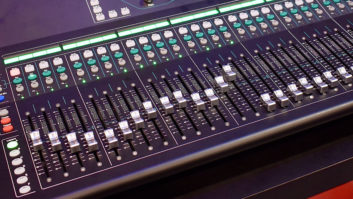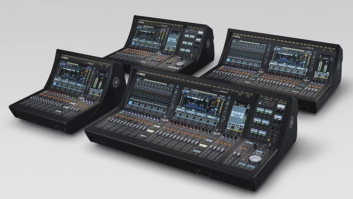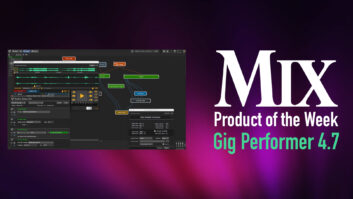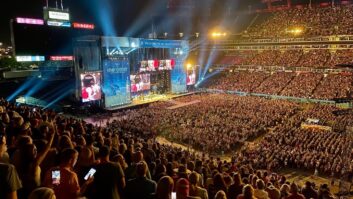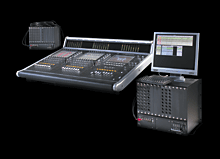
It wasn’t too long ago when “snapshot recall” on a live console meant that you took a Polaroid photo of the desk after the soundcheck was over. Today, snapshot or scene store and recall are standard features on virtually every digital console. Resetting the entire desk at the push of a button makes digital consoles a natural choice for multi-act tours, where each engineer can quickly and accurately access settings for their band with a minimum of soundcheck time, as well as for theater productions, where each act requires reconfiguration of audio I/O. Along with snapshots, most digital desks offer extensive internal processing, such as dynamics, multiband EQ, polarity reverse and delay on every channel; onboard effects processing with complete factory and user libraries; busing and auxiliary output options; and the ability to control any audio channel via any control strip.
DiGiCo D1 Live DiGiRack
Though many digital desks have onboard audio I/O, more advanced systems employ outboard AD/DAs. Removing I/O hardware from the control surface allows manufacturers to cram an incredible amount of control over a large number of channels into a small package — 16 or 24 faders control as many as 192 channels in several layers and a single dedicated channel “strip” facilitates control over a selected or active channel. This is a boon for small venues that are hesitant to give up seats to install a large desk at front of house. Further, placing converters at stage-side shortens the analog signal path for optimum audio quality.
Just about every digital console incorporates some means of storing data, whether on a memory card via MIDI SysEx or direct connection with a computer running proprietary software — all of which means that engineers can travel with their programs and have a favorite console provided locally, reducing the tour’s transportation costs.
This month, Mix surveys live sound digital consoles. If you’re considering purchasing a digital desk for your next tour, make the following buyer’s guide the first stop in your shopping spree.
DiGiCo‘s (www.digiconsoles.com) D5 Live 56 digital mixing system comprises a 64-channel work surface, a DiGiRack stage interface containing 56 A/D and eight D/A converters, and a second local DiGiRack residing next to the console, providing 56 external I/Os for inserts, effect send/returns, local monitoring and playback. The D5 Live is split into four sections of eight channels, each with an LCD touch screen. The center of the desk incorporates a “selected channel” section with dedicated hardware for channel control and an onscreen frequency display showing the EQ curve. Two master banks provide 16 faders that function as a matrix, group or aux out masters. Features include expansion slots for additional DSP and optional effects processor, snapshot recall, MADI port and a modem port for diagnostics and software updates. MSRPs: D5 Live 56 EX (40 analog, 16 digital I/O), $175,874; D5 Live 112 EX (with a second stage DiGiRack), $202,231; and D5 Live 112 FMX (monitor/FOH package), $352,436.
Featuring 40 mic/line inputs and 24 outputs, the D1 Live 40’s local DiGiRack enables it to function as a direct replacement for an analog console by using existing copper multipair from the stage. The D1 Live handles 64 mono/stereo channels and can be expanded to 160 channels, with access to 224 inputs, 224 outputs and 40 buses. The D1’s six independent effect processors generate reverb, delay, pitch change, multiband compressor and 28-band graphic EQ. Sixteen IPCs (insertable processing channels) include 6-band parametric EQ, compressor and delay, and may be inserted across any input or output. The D1 Live 48DP (Dual-Purpose) system extends the Live 40’s facilities with a total of 48 mic/line inputs and 16 IPCs. System packages start at $68,718.

Digidesign VENUE
Based around the D-Show mixing console, Digidesign’s (www.digidesign.com) VENUE system features an expandable DSP mix engine. A standard VENUE includes 48 mic inputs and can run 64 input channels with 24 graphic EQs and enough DSP power for dozens of plug-ins. All channels feature a remote-controlled head amp, delay, 4-band parametric EQ with analog emulation mode and dual dynamics processors. VENUE includes D-Verb, delay, pitch and dynamic plug-ins, and supports plug-ins from other manufacturers. The Assignable Channel Section (ACS) enables adjustment of all parameters for any selected channel. Optional sidecars may be added to increase fader count.
VENUE’s 19-inch Stage Rack provides analog audio I/O for stage signals, accommodating up to 48 remote-controlled mic/line preamps and A/D converters. The FOH Rack contains the D-Show mix engine and furnishes audio connectivity at the mix position. Automation includes snapshot store/recall (999 scenes), MIDI program change and response to incoming footswitch events or MTC cues. VENUE can be interfaced directly to Pro Tools using Digidesign’s FWx card or TDM Record Option. A standard VENUE system is $62,995.

Harrison Trion
Jointly developed by Harrison (www.harrisonconsoles.com) and Showco, the LPC’s extensive automated input selection system greatly reduces the number of active channels required for a given section of a performance, while proprietary IKIS™ event-based automation provides instant recall and reset of every function on the console (up to 10,000 setups). The LPC provides three mic and one line input per channel, motorized faders and pots, and 5.1 panning. Up to 32 mix buses or aux sends are available, as are 32 matrix outs. Audio I/O is 24-bit, while internal signal processing uses Harrison’s 40-bit Wide Pipe™ path. A TFT interface, alphanumeric display on all faders and 16 remote VCA faders help users manage shows with large numbers of inputs.
Designed with a small footprint and employing the company’s Wide Pipe signal path, Trion runs on Harrison’s IKIS platform and features built-in 15-inch monitors for a dedicated view of channel settings. Harrison’s PreView™ waveform envelope display gives the operator a 20-second-long waveform view of any audio source. Trion can incorporate from 32 to an unlimited number of dual input channels, each with 16 or 32 aux sends and 24, 48 or 96 bus assignments (dependent upon configuration). Channel controls and assignments are instantly accessible as vertically oriented strips or “folded out” across eight faders for true knob-per-function adjustment. The DTC™ (Digital Tools Card) adds a 20-second loop recorder and 32 digital bus limiters with look-ahead intelligence — becoming a gateway to DSP plug-ins. Adding a portable 8-fader panel and screen, a remote operator can control FOH or monitor mixes from anywhere in the venue.

InnovaSon Sy48
InnovaSon‘s (www.innovason.com) Sy80 provides 80 inputs, 80 outputs and 48 mix buses operating at 48 kHz/24-bit, with 32- to 40-bit internal processing. Fader-per-channel architecture provides simultaneous access to all 80 channels. In addition to the motorized fader, each channel has a dedicated LED meter and Cue/Select/Mute buttons. A Channel Control section provides instant, dedicated control over channel settings, while a 15-inch retractable screen displays channel information. InnovaSon’s XFAD™ expansion fader combinations allow an engineer to group several sources for control under one input fader. The Sy80 is controlled by Sensoft 8 PC-compatible software for editing and archiving of up to 1,000 pages per show. Export and import functions allow file transfers from console to PC and vice versa.
Housed in a compact package, InnovaSon’s Sy48 provides 64 channels with 48 local mic/line inputs, 16 local line inputs and 16 local line outputs for aux, inserts and bus sends. The Sy48 maintains InnovaSon’s fader-per-channel architecture, with Level Meter, Mute, Cue and Select buttons per channel. Faders are user-configurable as inputs, VCAs, groups, buses, aux, XFAD, matrix or crossfaders. Console features include a central control panel for channel parameters, 12-inch fold-down screens and stereo monitoring with PFL, AFL and APL (After Processing Level) listening on headphones or via allocated outputs. The Sy48 includes InnovaSon’s Sensoft management software, facilitating instant recall of console configurations; snapshot automation with manual or MIDI synchronization-enhanced Q/Page display and control for theater applications; and offline programming for show preparation.

Lawo mc2 66
Lawo‘s (www.lawo.de) mc2 66 digital mixing system comprises a mixing surface with integrated control system, HD Core DSP and routing matrix, and DALLIS audio I/O. Control surface size may be configured via 8-fader modules with systems from 16 + 8 faders to 48 + 8 faders, controlling up to 192 DSP channels and 144 mix buses. All console surface modules are “star-linked” to the control system so that configuration may be changed during operation without unwanted noise or data loss. Audio processing is performed at 48 or 96 kHz, with 24-bit resolution and 40-bit internal processing. Each input channel offers dynamics with look-ahead function, delay, insert, panning up to 7.1 and 32 aux sends. The DALLIS modular I/O system can be loaded with any combination of mic/line, AES, serial or SDI interface boards and up to 80 I/O per system. Comprehensive snapshot options store control panel assignments, DSP settings, matrix routing and I/O parameters.

LCS CueConsole
The CueConsole from LCS (www.lcsaudio.com) is a modular control surface that works with the company’s Matrix3 digital audio mixer. The 48kHz/32-bit system supports up to 280 inputs, 512 outputs, 256 buses and a 256×512 matrix controlled by Space Map®, the multichannel panner standard with every LCS system. A CueConsole/Matrix system incorporates dedicated hardware, negating the need for a computer while running the show. Automation features one-button capture of all controls and individual wait and fade time settings for each fader, panpot and matrix. Additional features include unlimited presets and multiplatform software support (Mac OS X, Windows XP Pro, Linux). Options include built-in digital multitrack playback and a Variable Room Acoustic System. Pricing is dependent upon configuration; a FOH system with 48 inputs, 16 outputs, I/O processing and 32 motorized faders starts at around $110k.

Mackie TT24
Mackie‘s (www.mackie.com) TT24 is a midsized, 24-bit/96kHz digital console optimized for live sound. Each of 24 mic/line channels includes a 100mm motorized fader, rear panel XLR/TRS balanced input and TRS insert. Eight additional line inputs include 4-band EQ and can be stereo-linked (as can the mic/line inputs). A Select Follows Solo function automatically brings a soloed (or selected) channel to the desk’s QuickMix section for fast adjustment of EQ and dynamics. Three internal 31-band graphic equalizers can be used to process left, right and center outputs. Rear panel XLRs are provided for 12 aux sends, L/R and mono/center outputs. Digital connectivity includes ADAT optical, AES/EBU, S/PDIF, word clock and MIDI I/O. A USB port links the TT24 to a PC running Mackie’s TT Control software for control over every desk parameter. Two expansion card slots facilitate a variety of I/O options. Pricing starts at $7,199.

Stagetec AURUS
Stagetec‘s (www.stagetec.com) AURUS provides access to as many as 300 channels via up to 96 channel strips. Microphone inputs feature the company’s 28-bit TrueMatch A/D conversion, while line inputs feature 24-bit TrueMatch A/D conversion. AURUS operates at sample rates of 44.1/48/96 kHz, with 40-bit internal processing. A central channel panel provides all settings typically needed during normal operation. AURUS works with Stagetec’s NEXUS audio network. DSP is integrated into the chassis of the NEXUS STAR, a rackmount unit housing all audio processing components and provides routing (as required by the user) for analog mic/line input and line out or a variety of digital I/O. Two different channel types (full and short) adapt available DSP resources to project-specific applications. PC-compatible software facilitates automation for compete store and recall of all system settings on- or offline, though a computer is not required for use during production. Pricing is dependent on configuration.
Yamaha‘s PM1D (www.yamaha.com/proaudio) Version 2 system comprises a CS1DV2 control surface and DSP1DV2 or DSP1DV2-EX rackmount processing engines, both of which deliver 28-bit A/D and 27-bit D/A conversion. The CS1DV2 has four 12-channel assignable input control sections; the console’s Flip switch provides access to an additional 48 channels. Controls for the selected channel are accessible via analog-style controls with a color LCD showing channel settings. The DSP1DV2 engine supports 56 channels, while the DSP1DV2-EX runs 112. Output complement includes two main stereos, 48 mix buses and 24 matrix, each with 6-band parametric EQ, delay and compressor. Inserts and direct outputs are available for all channels, while 12 DCA groups simplify complex mixing systems.
Version 2’s Add-On Effects include a studio-grade compressor, vintage EQ, tape-saturation simulation and Yamaha’s Reverberator REV-X. The PM1D V. 2 provides data backup via USB or serial port, as well as PCMCIA card. The CS1DV2 control surface starts at $66,000; DSP1DV2 at $17,400; and DSP1D-EX at $19,500.

Yamaha PM5D
Yamaha’s PM5D ($49,800) and PM5D-RH ($67,000) come in two basic configurations: The PM5D includes 48 analog XLR/TRS inputs with manual mic pre’s, while the PM5D-RH offers 48 analog XLR mic inputs with recallable gain. A 24-channel work surface mixes up to 64 inputs. Using the PM5D’s internal digital patchbay and four rear panel mini-YGDAI slots, a user can instantly scene-switch between totally discrete stage setups of up to 130 inputs. Separate stereo and LCR buses are furnished, along with 24 submaster or aux send mix buses, eight DCA faders and an 8-output mix matrix. Eight independent SPX2000-class multi-effects processors can be patched into any channel. The PM5D supports surround panning from 3.1 to 6.1, and has a 500-scene memory. The PM5D is ready for Yamaha’s Add-On Effects and includes the REV-X Reverb. Other effects such as the Compressor276, Compressor260, EQ601 and Open Deck can be obtained by purchasing the Channel Strip and Master Strip packages.
The company’s DM2000 ($18,600) controls 96 channels in four layers of 24 at any sample rate up to 96 kHz with 24-bit resolution and 32-bit internal processing. Twenty-four channels of balanced XLR mic/TRS line-level input feature phantom power, trim control, pad and balanced insert send and return. Additional inputs may be added via six rear panel mini-YGDAI card slots. A Selected Channel section provides dedicated encoders to adjust channel parameters. In addition to independent compression and gating on each channel, six 31-band graphic EQs may be patched to any desired signal path. Thirty output buses (eight subgroup, 12 aux, L/R stereo and four stereo matrix) may be assigned to any output connector. Eight onboard effect processors can be fed from auxiliary buses or inserted directly into input channels. All DM2000 V. 2 inputs, outputs, effects and inserts can be assigned to any of the console’s channels via internal digital patching. The DM2000 features snapshot recall, complete DAW control, MMC and Yamaha’s Automix dynamic automation. Studio Manager V. 2 software places control of every desk parameter into a PC or Mac. The DM2000 V. 2 also offers 96kHz effects, access to Yamaha’s Add-On Effects package and memory card — based data management.
The DM1000 V. 2 ($5,599) handles 48 channels of audio at sample rates up to 96 kHz/24-bit with 32-bit internal processing. The DM1000 is equipped with 20 analog XLR inputs and 12 analog XLR outputs. Two mini-YGDAI slots allow the DM1000 to be used with ADAT, Tascam or AES/EBU digital formats, as well as additional analog I/O. Channels are organized in three layers under 17 touch-sensitive motorized faders. Eight auxiliary buses can be patched anywhere in the system, and patch setups can be stored in the onboard library for instant recall. In addition to scene recall, the board features Yamaha’s Automix Automation and Studio Manager software for computer control and management. The DM1000 can be used for DAW control over Pro Tools, Logic Audio and Nuendo. A mini-joystick, multichannel routing with bass management and independent speaker delay facilitate surround mixing.
In addition to contributing to Mix, Steve LaCerra is the tour manager and front-of-house engineer for Blue Öyster Cult.
